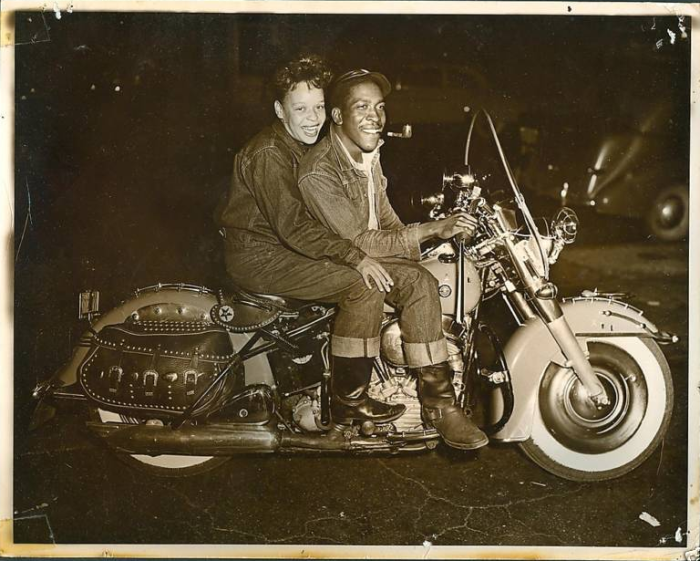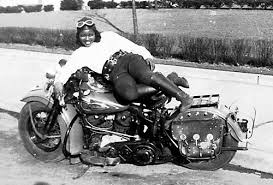
The story of the early days of motorcycle clubs is well known. Soldiers returning from the trenches and the skies of World War II formed clubs centered on motorcycles and the camaraderie and brotherhood they shared in the military.
Though perhaps not intentional, this history has almost always failed to recognize the African Americans who lived the same story — and did so while facing resistance from mainstream society, other motorcycle clubs, and even other African Americans.
But their love of motorcycles and unwavering persistence won out, eventually transcending the racism of the day and overcoming the prejudices and challenges they faced.
The stories of these early black riders are nothing less than heroic. Their legacy lives on among riders today — black and white — who share the love of the open road and respect the traditions of the past that helped shape the motorcycle world today.
Today’s post will highlight the background of Bessie Stringfield.
Bessie Stringfield’s life is the stuff of which legends are made. Bessie has been mentioned in books, magazines, newspapers and television documentaries. In 1990, when the American Motorcyclist Association opened its Motorcycle Heritage Museum, Bessie featured in its inaugural exhibit on Women in Motorcycling. A decade later the AMA created the Bessie Stringfield Award to honor women who are leaders in motorcycling. In 2002, she was inducted into the Motorcycle Hall of Fame. Bessie, or BB as she was known among friends, described over 60 years of motorcycling: “I was somethin’! What I did was fun and I loved it.”
Bessie Stringfield (1911–1993), nicknamed “The Motorcycle Queen of Miami”, was the first African-American woman to ride across the United States solo, and during World War II she served as one of the few motorcycle despatch riders for the United States military.
Credited with breaking down barriers for both women and African American motorcyclists, Stringfield was inducted into theMotorcycle Hall of Fame.; the award bestowed by the American Motorcyclist Association for ‘Superior Achievement by a Female Motorcyclist’ is named in her honor.
Stringfield was born in Kingston, Jamaica in 1911, but her parents migrated to Boston when she was still young. Her parents died when Stringfield was five and she was adopted and raised by an Irish woman.
At the age of sixteen Stringfield taught herself to ride her first motorcycle, a 1928 Indian Scout. At the age of nineteen she commenced traveling across the United States and eventually rode through the 48 lower states, Europe, Brazil and Haiti. During this time she earned money from performing motorcycle stunts in carnival shows. Due to her skin color, Stringfield was often denied accommodation while traveling, so she would sleep on her motorcycle at filling stations. Due to her sex, she was refused prizes in flat track races she entered.
Bessie’s faith got her through many nights. “If you had black skin you couldn’t get a place to stay,” she said. “I knew the Lord would take care of me and He did. If I found black folks, I’d stay with them. If not, I’d sleep at filling stations on my motorcycle.” Bessie folded her jacket on the handlebars as a pillow and rested her feet on the rear mudguard.
During WWII Stringfield served as a civilian courier for the US Army, carrying documents between domestic army bases. During the four years she worked for the Army she crossed the United States eight times. She regularly encountered racism during this time, reportedly being deliberately knocked down by a white male in a pickup truck while traveling in the South.
Between her travels, Bessie wed and divorced six times, declaring, “If you kissed, you got married.” She and her first husband were deeply saddened by the loss of three babies and Bessie had no more children. On divorcing her third husband, Arthur Stringfield, she said, “He asked me to keep his name because I’d made it famous!”
In the 1950’s Stringfield moved to Miami, Florida where at first she was told “nigger women are not allowed to ride motorcycles” by the local police. However, she qualified as a nurse there and founded the Iron Horse Motorcycle Club. Her skill and antics at motorcycle shows gained the attention of the local press, leading to the nickname of “The Negro Motorcycle Queen”. This nickname later changed to “The Motorcycle Queen of Miami”, a moniker she carried for the remainder of her life. In 1990 the AMA paid tribute to her in their inaugural “Heroes of Harley-Davidson” exhibition she having owned 27 of their motorcycles. Stringfield died in 1993 at the age of 82 from a heart condition having kept riding right up until the time of her death.
In 2000 the AMA created the “Bessie Stringfield Memorial Award” to recognize outstanding achievement by a female motorcyclist, and Stringfield was inducted into the Motorcycle Hall of Fame in 2002.


